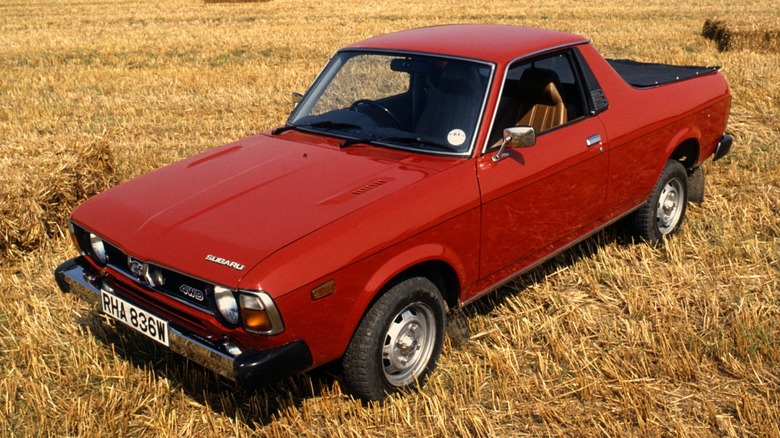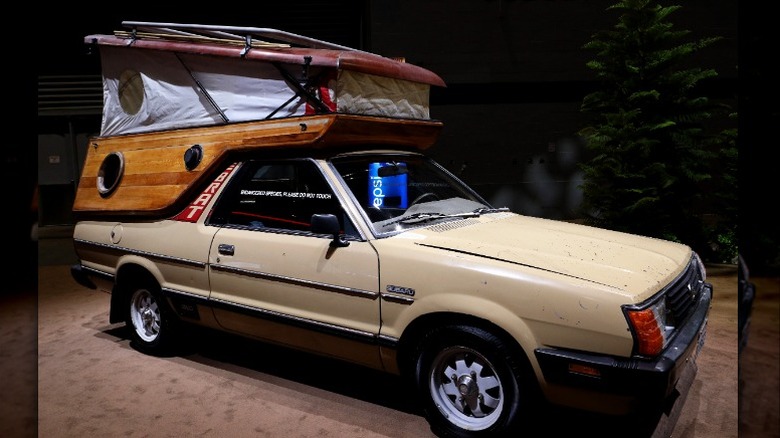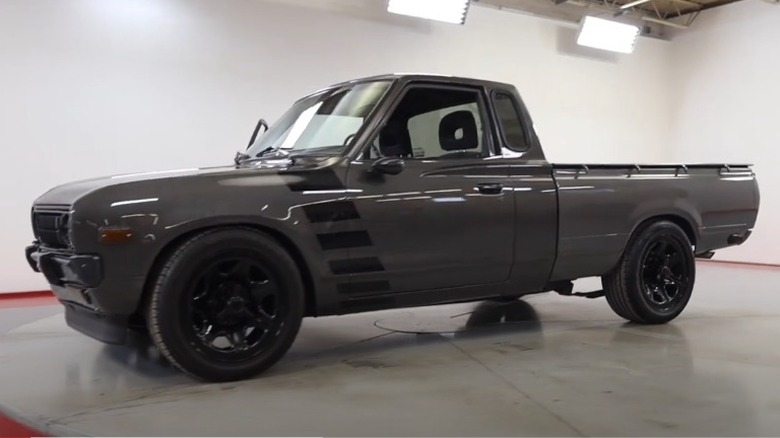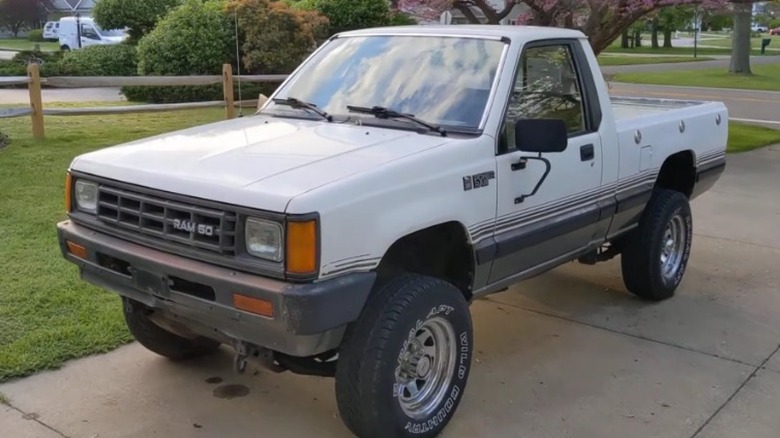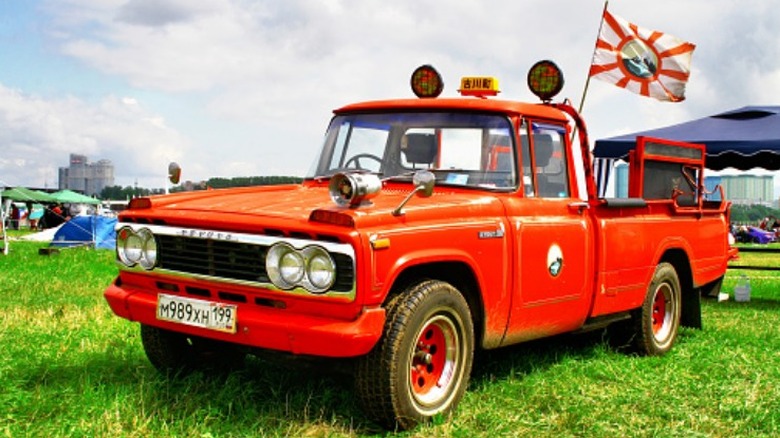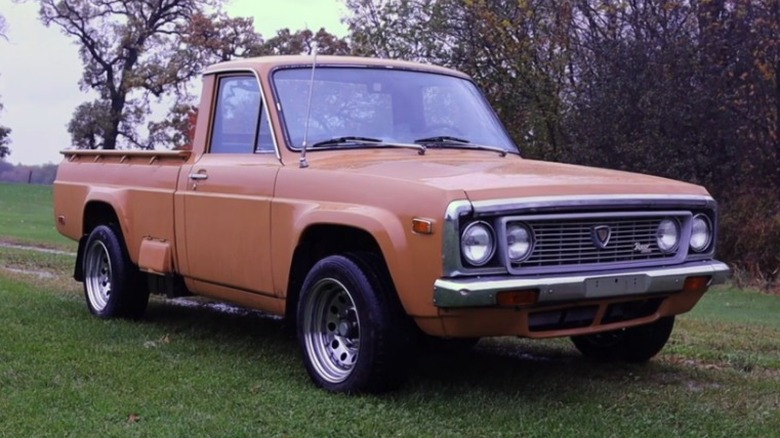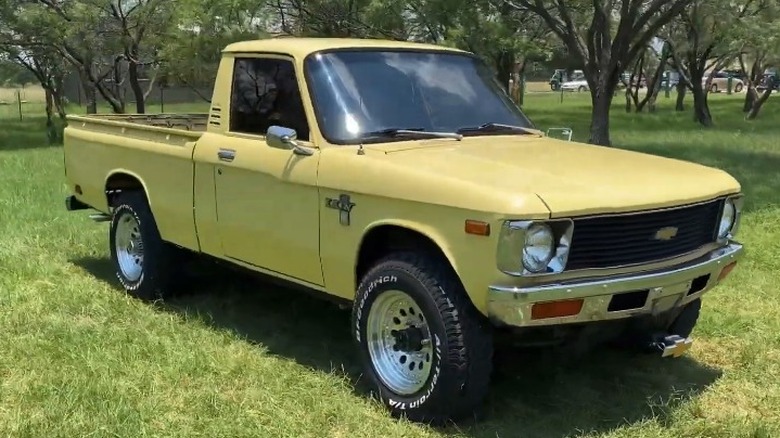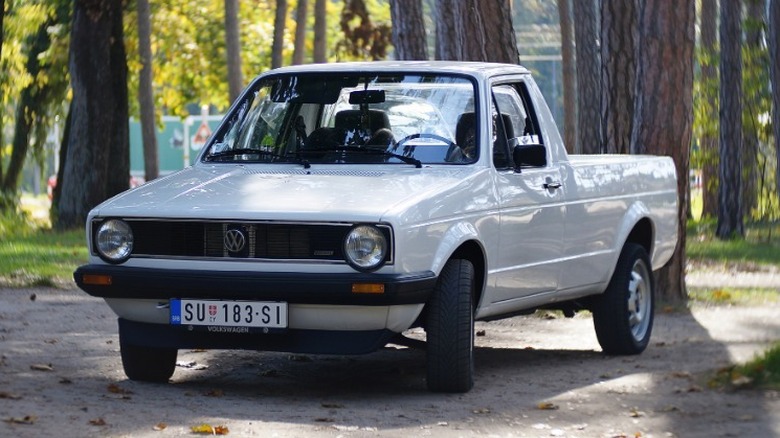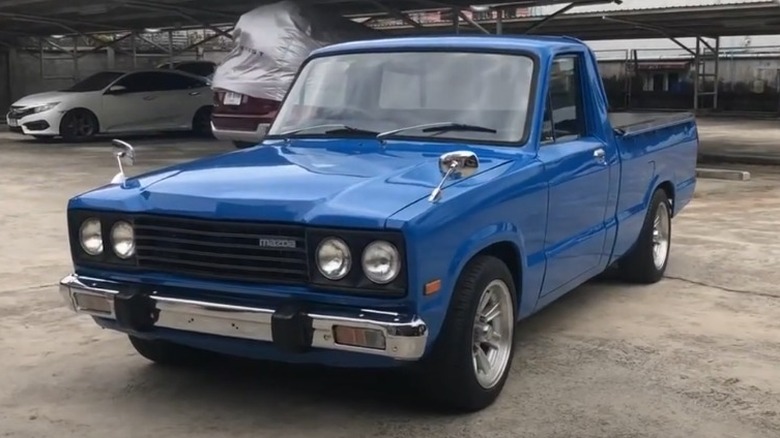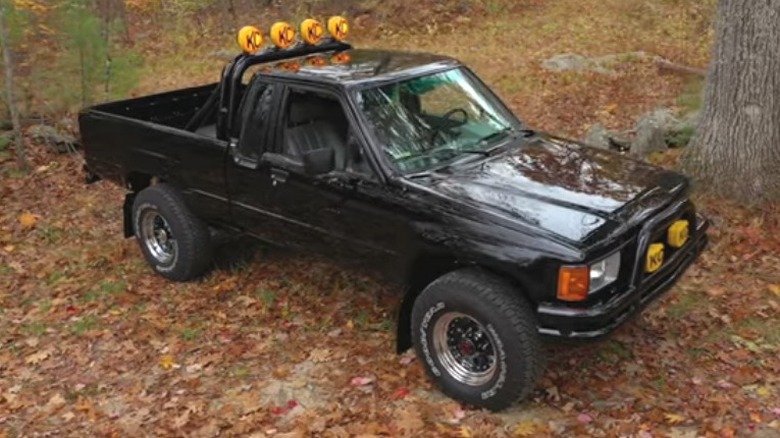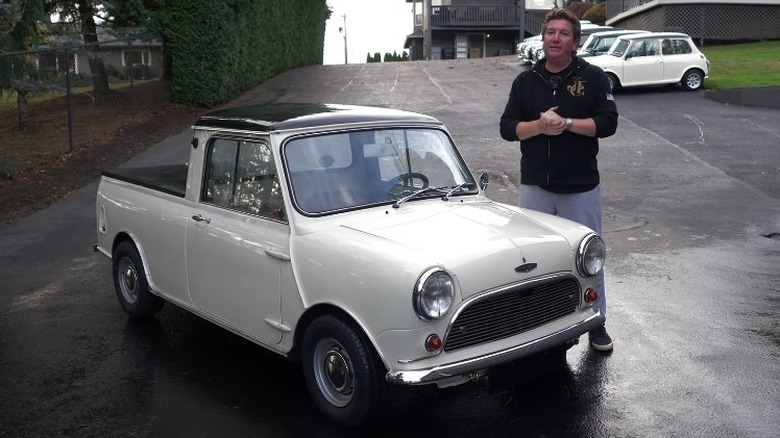10 Classic Mini-Trucks We'd Gladly Choose As A Daily Driver Over Any Modern Pickup
Modern trucks spoil us with creature comforts and such trivial things as efficiency and reliability. A world without Android Auto, automatic climate control, and blind spot monitoring may seem inconceivable, but that is the world many of us lived in for decades and still others may want to live in again. For small trucks, choices are somewhat limited nowadays to the Ford Maverick, Hyundai Santa Cruz, and the slightly larger Ford Ranger and Chevrolet Colorado. These are all great trucks, but those of us who prefer a small truck with limited safety features and questionable acceleration must look to the past.
Mini trucks rose to prominence with the invasion of Japanese brands beginning in the 1960s and hit their stride in the 1970s. These proved to be robust and efficient little workhorses that were seemingly indestructible, continuing to run long past the point that normal cars would have croaked. These pint-sized cargo haulers are not necessarily comfortable or luxurious, but each has its own unique charm. The opportunity to drive a classic mini truck is a chance to connect with the road in a simple and humble little truck. Furthermore, the custom truck scene is alive and well, and classic mini trucks are an excellent canvas for unique custom creations. Therefore, in a world without the usual considerations and roadblocks to buying a classic vehicle, these mini trucks are what we would drive over a given modern model if given the chance.
Subaru BRAT
In the world of imported mini trucks, the Subaru BRAT is unique to the point of bordering on bizarre, but it is oh-so-endearing. The name is a sort of forced acronym for Bi-Drive Recreational All-terrain Transporter, referring to the all-wheel-drive system that has always defined the Subaru brand. The other defining characteristic of Subaru is the boxer engine, and the BmodelRAT is powered by a 4-cylinder version cranking out a whopping 61 horsepower in the early versions and up to an astounding 95 horsepower in the later turbocharged models.
Styling of the BRAT is also unique, built upon a monocoque chassis borrowed from one of the passenger vehicles and converted into a truck. The design is kind of a love-it-or-hate-it affair, but it could be had with t-tops, which is always a bonus. The best feature is the rear seats installed in the bed so Subaru could avoid paying a 25% tariff imposed on light trucks, aka the chicken tax. Sitting in the bed of a tiny truck in some iffy seats may not be the best idea, but your kids will love it.
The BRAT is a well-built little truck that would be a dependable vehicle if kept in good running order, but they are exceedingly rare to find these days. It is not all too good for hauling much as it is underpowered and has a low payload capacity, but it is such a fun little ride, none of that really matters.
Datsun 620
Nissan's vehicles were branded as Datsun for decades since the founding of the company in the 1930s. The post-war period saw the emergence of a robust manufacturing segment in Japan's auto industry, and small trucks would be one of the first exports sent to the American market. The first few models saw limited success, but the Datsun 620 of the '70s became one of America's favorite small trucks of the period.
With the 620 model came more robust engine options with a base model 1.6-liter 4-cylinder able to be upgraded all the way to a 2.0-liter engine making 110 horsepower. While those numbers seem paltry by today's standards, they were plenty to haul up to 1,000 pounds of cargo, and these little frames could handle it. These trucks were bare-bones and simple, meaning the engines had no extra superfluous weight to haul around. They are also dependable, but when they did break down, repairs were easy and nothing blocked access under the hood.
Today there are a couple of options for driving an old Datsun. Some may take one perfectly restored to its original condition just to enjoy the simplicity and the joy of a leisurely drive to the store to pick up some mulch for the garden. Others use these for custom rides and the options are endless. Regardless, it will turn heads on the street.
Mitsubishi Mighty Max
Chrysler maintained a longstanding technical relationship with Mitsubishi for many years and first introduced its trucks as rebadged Dodge and Plymouth models in 1979. Mitsubishi would later establish its own dealer network and sell small pickups in the U.S. Among those models was the Mighty Max, which many would consider to be among the best Japan had to offer at the time.
The Mitsubishi Mighty Max was also imported as the Ram 50 or Power Ram 50 and could be had with 4- or 6-cylinder engines, among the largest offered at the time, and a regular or extended cab. These trucks were attractively styled and the interiors were well-trimmed, making them basic but comfortable places to spend some time on the highway.
For modern purposes, a V6 model with four-wheel-drive and an extended cab in a retro Overlander sort of custom setup would be grand. Taking a tough little Mitsubishi out into the desert or up a mountain trail to set up camp for the night sounds like a perfect way to reconnect with nature and get away from it all. It would also be doing it in a fashionable and retro style.
Toyota Stout
From 1964 to 1969, Toyota exported a truck to the U.S. that pre-dated its legendary Hilux (aka Toyota Truck). This was the Stout, and it marked the beginning of Toyota truck history in North America. While it is often overlooked, the little trucks were remarkable, especially when considering the time in which they were available. Back then, trucks were large and unwieldy things people bought to do work and little else. But this little Toyota came along and showed that a truck could be easy to drive, reliable, efficient, and remarkably capable. The size of the Stout was also a bit larger than the wave of Japanese trucks to come later, more like a mid-size truck of its day.
The Stout came with a 1.9-liter 4-cylinder engine, a larger offering than competitors, that offered more than adequate power for the diminutive truck. The Stout would be a fantastic classic daily driver because it is rare. Sales of the Stout were not great and not a lot of people remember them — certainly not in the way the later Toyota trucks are recalled by so many. Its wholly unique look with a popup turn signal lights makes it a perfect city cruiser that would be useful for striking up a conversation.
Mazda REPU
In 1967, Mazda released a very special sports car called the Cosmo. It was unique for the fact that its engine was a Wankel rotary engine, beginning the long production history of Mazda's rotary engines. While the Cosmo was a limited production sports car for the domestic market only, the engine spread to other models, including the American-market-only Mazda REPU, or Rotary Engine Pick Up.
Wanting to expand the use of its quirky little engines, Mazda stuffed the same 110-horsepower dual-rotor engine from its RX-2 passenger car into its existing pickup. The body received fender flares and wider tires and the interior was upgraded as well, making it among the nicest of any small truck available at the time. Mazda was also extra proud of its engine as the tailgate had "Rotary Power" embossed in large letters across its length. However, it was terrible for truck purposes. The rotary engine is notorious for its lack of torque and the early ones especially had huge sealing problems. It only lasted a few years and the Wankel was relegated to sports car use only, although Mazda won several races with its REPU.
Nobody in their right mind would want a rotary pickup. However, those nutty Mazda gearheads should love to have a REPU to install all manner of custom-built 13b and 20b engines to crank up the power and add turbos and whatever else crazy Mazda fanatics do. This would make the REPU a fantastic classic daily truck to drive.
Chevrolet LUV
Before Chevrolet created the S-10 small pickup, it imported an Isuzu model and called it the LUV, or Light Utility Vehicle. With the new LUV, you got the most basic pickup possible. It came with a 1.8-liter engine pushing just 75 horsepower backed up by a 4-speed gearbox and a steering wheel. No power steering, power windows, or power locks, and bucket seats came optional. Just the minimum of instrumentation was installed on the dashboard. However, it could haul 1,000 pounds of cargo and the Isuzu engine proved very reliable.
The LUV continued throughout the '70s unchanged but did receive front disc brakes in 1976 and an option for 3-speed automatic transmission. In 1981, the truck was redesigned with a more modern look but remained as basic as ever. A diesel engine was also offered at one point, and, being from Isuzu, the diesel is near-indestructible and offered fuel mileage modern cars would be envious of, although the 58 horsepower is less enviable. 1982 would be the last year for LUV as Chevrolet put all of its efforts into the new S-10.
LUVs prices today can be surprisingly high, with examples in very good condition selling for more than $20,000. Despite being such a simple little truck, they appear to be very desirable to collectors. If one is found for sale, the best thing to do is to buy it and just drive it in whatever condition it is found.
Volkswagen Rabbit Pickup
The Rabbit was Volkswagen's follow-up to the Type 1 Beetle and was created in West Germany. The pickup version of the little hatchback was an American creation from the Pennsylvania factory. Americans working at VW of America took a Rabbit, hacked the rear up to create a pickup bed, added a rear window, and started selling a truck. The pickup came out as a 1979 model and sold until 1984.
Most Rabbit pickups were sold with the 1.6-liter diesel engine, although they could be had with the same 1.6-liter gasoline option from the passenger car. With the diesel, you received 52 horsepower to motivate your little truck, and a tailwind was almost a necessity in getting up an incline. But the trucks were reliable and adorable and people loved them. With only a couple of bucket seats and little in the way of options, the Rabbit could carry two people and a few hundred pounds worth of gardening supplies, but not much heavy work could be accomplished with one of these.
Today there is no reason to drive a Rabbit except for leisure. They are too slow to be good for much leisure, however, as modern traffic can make a drive downright frightening. The good money would be to drive one like a VW Sportruck model sold recently on Bring a Trailer, in which someone swapped the wimpy 4-cylinder for a VW 2.8-liter VR6 engine with custom intake and exhaust to make it worth driving.
Mazda B-series
Production of Mazda's B-series truck commenced in 1961 with its very small B1500 model, powered by a 1.5-liter engine, and showed the way all B-series trucks would be named. These first models would be sold domestically and to some select Asian markets, but it would not be until 1972 that it arrived on American shores with both a Mazda badge and a Ford badge as the Courier.
The first model sold in the U.S. was the B1800, also only sold in this market. It introduced Americans to Mazda's excellent engineering with its robust and reliable small truck, which, much like the others, offered just the basics with a spartan interior. It was also rated for a payload of 1,000 pounds and returned excellent fuel economy. 1980 saw Mazda release the B2000 with a larger 2.0-liter engine, complemented a year later by a 2.2-liter Mazda diesel engine in a B2200. The truck was updated in 1985 and the largest engine offering in the B2600 arrived in 1987 using the same 2.6-liter Mitsubishi engine found in the Mighty Max.
The later B-series trucks were the most attractive of the imported mini trucks and their reliability is legendary. In an ironic twist, Mazda would later sell rebadged Ford Rangers as B-series trucks, but they were cheap imitations not desirable today. The B-series is perhaps the best choice for a lowrider custom and that would be the Mazda truck to drive today.
Toyota Hilux - 4th generation
The Toyota Hilux of all generations is an iconic vehicle that has become practically a legend, and it is still in production. The model line stretches from the '60s to the present, but the choice for a daily driver is from the '80s. The reason why is Marty McFly. When the movie Back to the Future came out, it not only made the DeLorean an overnight sensation, it made a lifted 1984 Toyota truck cool as well. The truck is a good runner, but it is also quite attractive in its own right.
For people of a certain age, if you mention mini trucks, these are what come to mind. The Toyota styling is conservative as always, but with the proper blend of lines and curves to make them appealing. The added flourishes like the small window behind the door for the extended cab are just that little extra. These trucks are unkillable, as evidenced by the 1980s-era Hilux of Top Gear fame that ran despite an arduous series of torture. But for a modern daily drive, it must be a 1984 Toyota truck in black with big all-terrain tires and a KC light bar on the bed and another crash bar with KC lights on the front, just like in the movie. Driving that, you will make friends everywhere.
Austin Mini Pickup
The mini truck has been popular among specific segments of the population for years now, but none took the "mini" designation as literally as Austin Motor Company's Mini pickup. Only available in Europe, the Austin Mini is the iconic British small car that took the world by storm in the 1960s. It was an adorable and affordable little British car that happened to also be pretty innovative. The Mini introduced the idea of having a transversely-mounted engine driving the front wheels, making it possible to leave ample room in a small passenger compartment. It also merged the engine and transmission together, sharing the same oil supply, to save space, something Lamborghini copied with its iconic Miura supercar.
Although 5.3 million units of the Mini were made in its 41-year run, only about 60,000 of them were built as a pickup. These little runabouts are hard to find today. As far as pickup trucks go, the Mini is probably the smallest as even some Japanese kei trucks would dwarf it. But for a car with an iconic look and legendary status, it doesn't get much better than a Mini.
Daily driving any Austin Mini on American roads can be a harrowing experience. With the size of some trucks and SUVs, a Mini looks as if it could be crushed in an instant. But driving a Mini truck could be an exciting experience if kept in city centers, especially where parking is at a premium.
